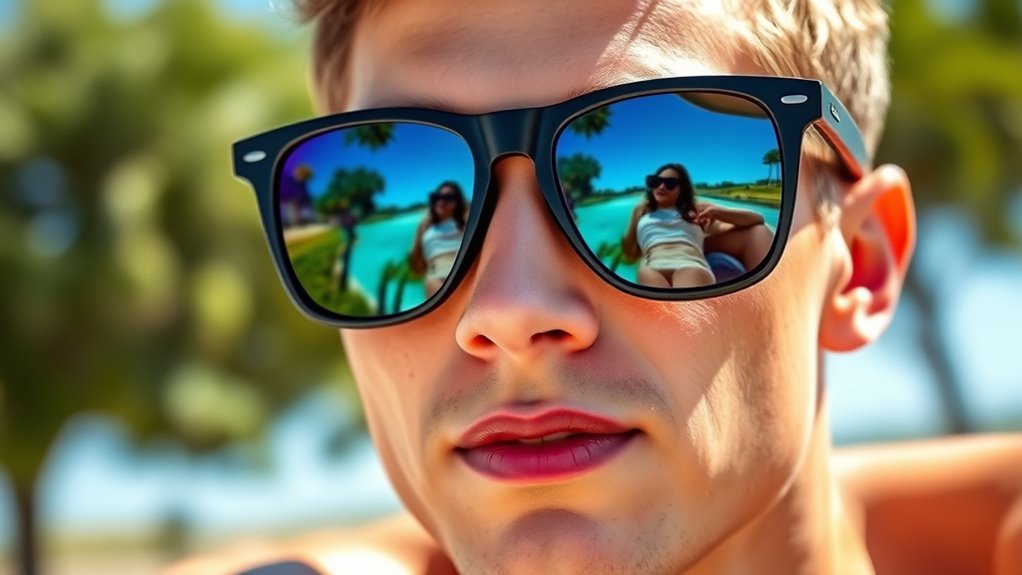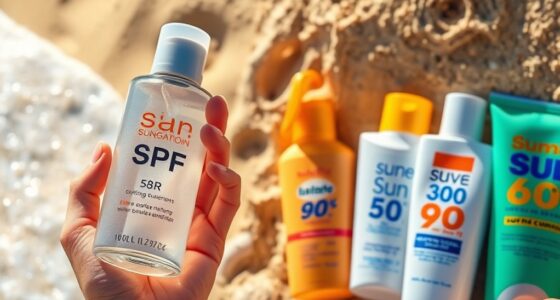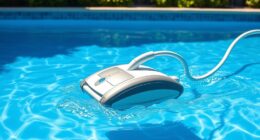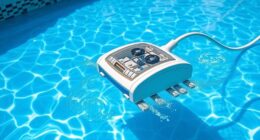To protect your eyes while tanning, always wear FDA-approved UV-blocking eyewear that covers your eyes completely, like goggles or sunglasses with 99-100% UVA and UVB protection. Avoid wearing contact lenses during tanning sessions, especially if they’re hard lenses, as they can trap UV rays and cause dryness or damage. Remember, closing your eyes isn’t enough; proper goggles are essential. Learn more about smart eye safety practices to enjoy tanning without risking your vision.
Key Takeaways
- Always wear FDA-approved, UV-blocking protective eyewear designed for tanning beds or outdoor sun exposure.
- Limit exposure time and avoid wearing contact lenses during tanning to prevent dryness and UV trapping.
- Keep eyes closed, but understand that eyelids only block about 25% of UV rays; use proper goggles for full protection.
- Regularly clean and maintain your protective eyewear to ensure maximum UV protection and hygiene.
- When outdoors, choose sunglasses with 100% UVA and UVB protection, impact resistance, and wrap-around coverage.
The Importance of FDA-Approved Protective Eyewear

Have you ever wondered why wearing FDA-approved protective eyewear during tanning is so important? These goggles meet strict standards, like those in 21 CFR 1040.20, ensuring they block over 99.9% of UV-B rays and over 99% of UVA rays. This level of protection reduces your risk of eye damage caused by harmful UV radiation from tanning lamps. Understanding UV protection standards is crucial for making informed choices about safety during tanning sessions. FDA compliance means the eyewear has undergone rigorous testing and meets safety requirements, giving you confidence during your session. There are different styles, including goggles and sunnies, designed for comfort and effective coverage. Soft, flexible materials and elastic straps help keep the eyewear secure, minimizing discomfort and preventing accidental exposure. Wearing FDA-approved eyewear is essential to protect your eyes and ensure a safe tanning experience. Properly certified protective eyewear often incorporates UV-resistant materials that further enhance safety and durability. Additionally, staying informed about UV protection standards can help prevent potential risks associated with emerging technologies. Furthermore, advancements in automated safety features in protective eyewear can provide enhanced security during tanning.
Risks Associated With Tanning Without Eye Protection

Tanning without eye protection can lead to immediate and long-term eye damage, as UV radiation penetrates unshielded tissues. You might experience photokeratitis, a painful corneal sunburn causing redness, itching, watery eyes, and blurry vision after just one session. Dry eye symptoms and irritation are common, since eyelids filter only about 25% of UV rays, leaving your eyes vulnerable. Over time, repeated exposure increases the risk of cataracts, macular degeneration, and ocular surface cancers, which can impair vision or require surgery. Tanning beds emit intense UVA and UVB rays at close range, intensifying the danger. Without proper protection, UV rays can cause retinal damage, color vision deterioration, and even long-term blindness. Always wear FDA-approved goggles to minimize these severe risks. Additionally, protecting your eyes with appropriate gear is crucial to prevent lasting harm from UV exposure, especially since UV damage accumulates over time and can have irreversible consequences. Proper eye protection can significantly reduce the risk of UV-related eye conditions, including those linked to emerging trends like Nike Tech and other innovative materials that increase exposure risks. Regular use of appropriate eye protection can also help prevent the development of cataracts and other vision-threatening issues caused by cumulative UV exposure.
Proper Use and Handling of Contact Lenses During Tanning

To protect your eyes during tanning, it’s essential to handle contact lenses properly. Hard lenses should be removed before tanning to prevent dehydration and reduce UV trapping against your eye surface, which can cause irritation or damage. Wearing lenses during tanning increases the risk of dryness, redness, and discomfort, especially with heat from the bed. The warmth can dry out lenses, impairing their performance and causing discomfort. Removing your contacts decreases these risks, so always take them out beforehand. If you must wear lenses, use full-coverage goggles designed for tanning beds to block UV rays and protect your eyes. Limit your session duration to reduce UV exposure and consult your eye care provider for personalized advice on safe contact lens use during tanning. Additionally, staying informed about AI-driven innovations in healthcare can help you make better choices regarding eye safety and overall well-being.
Additional Safeguards: Eye Closure and Hygiene Practices

While closing your eyes during tanning might seem like a natural way to protect them, it offers limited safety since UV rays can penetrate even closed eyelids. Eyelids only block about 25% of UV radiation, leaving your eyes vulnerable to damage like photokeratitis and tissue harm. The thin skin of your eyelids is also prone to UV burns. Relying solely on eye closure increases the risk of long-term issues such as cataracts. To enhance protection, use properly fitted goggles labeled as providing 100% UV coverage, and clean them thoroughly between uses to prevent infections. Disposable goggles or eye stickers are good alternatives. Proper hygiene and protective gear are essential for safe tanning. Additionally, understanding the contrast ratio of your protective equipment can help ensure your eyes are adequately shielded from harmful UV exposure. Maintaining a digital literacy approach to eye safety can also help you stay informed about effective protective practices. Studies show that UV protection standards are crucial for preventing eye damage during tanning. Incorporating advanced protective gear with higher UV filtering capabilities can further reduce risks. For optimal safety, consider choosing tanning beds with built-in UV filters and adjustable intensity settings. After tanning, rinse your eyes if irritated, avoid rubbing them, and consult an eye care professional if symptoms persist.
Outdoor Sun Safety: Choosing the Right Sunglasses

Are you choosing the right sunglasses to protect your eyes outdoors? To maximize protection, pick sunglasses that block 99-100% of UVA and UVB rays, preventing damage like cataracts and macular degeneration. Look for ANSI Z87.1 certification, which guarantees UV protection and impact resistance, especially if you’re active outside. Polarized lenses reduce glare from surfaces like water and pavement, improving clarity and reducing eyestrain. For added safety, opt for wrap-around frames and side shields that block peripheral UV rays and debris. Choose lenses with anti-fog and scratch-resistant coatings to maintain clear vision and durability. Properly selected sunglasses protect your eyes from harmful rays, glare, and impacts, keeping your eyes safe while tanning outdoors. Additionally, selecting sunglasses with proper installation and maintenance ensures they remain effective over time and provide lasting eye protection. Considering UV protection standards when choosing sunglasses helps guarantee optimal safety features are met and maintained. Staying informed about market growth in AI tech can also inspire innovative ways to enhance their design and functionality. Understanding creative practice encourages individuals to explore different ways to enhance their eye health and overall well-being.
Frequently Asked Questions
Can Protective Goggles Cause Discomfort or Headaches During Tanning?
Protective goggles can cause discomfort or headaches if they don’t fit properly, are too tight, or have poor design. Straps that are too tight press on your head, and poorly fitted frames can cause pressure points. Non-ventilated goggles trap heat, increasing discomfort. Additionally, low-quality lenses might cause eye strain or optical distortion, leading to headaches. Always choose well-designed, properly fitting goggles to minimize these issues and guarantee comfortable, effective protection.
Are There Specific Brands of Goggles Recommended for Optimal Eye Protection?
When choosing goggles for your tanning sessions, look for trusted brands like Super Sunnies and Sperti that offer medical-grade protection. These brands block over 99% of UVA and UVB rays, ensuring your eyes stay safe. They also feature comfort-focused designs like flexible nose bridges and secure elastic bands. Prioritize these reputable options to get reliable protection, comfort, and peace of mind during every tanning session.
How Often Should I Replace My Disposable Eye Stickers or Goggles?
Did you know using disposable eye protection only once decreases infection risk by up to 90%? You should use a new disposable eye sticker for each tanning session to avoid contamination. Reusable goggles should be replaced every three months or if damaged or dirty. Always clean them thoroughly after each use, store properly, and avoid reusing disposables to guarantee your eyes stay safe and protected during tanning.
Do Different Skin Types Require Different Eye Protection Measures?
Different skin types don’t require entirely different eye protection measures, but you should always use high-quality, well-fitting protective eyewear. Light skin types are more UV-sensitive, so they benefit from extra caution, while darker skin types still need protection, as UV damage can occur internally. Federal standards require filters that block 99.9% of UVB and 99% of UVA. Prioritize comfort, fit, and compliance to guarantee maximum eye safety during tanning.
Can Eye Makeup Interfere With the Effectiveness of Protective Goggles?
Think of your eye makeup as a barrier that could sneakily sneak past your protective goggles. While properly fitted goggles should keep UV rays out, thick or smudged makeup might seep into the edges, creating tiny gaps. This can reduce their effectiveness. To stay safe, it’s best to wear minimal makeup or avoid it altogether when tanning, ensuring your goggles do their job without interference.
Conclusion
Just as Icarus warned us about overreaching the sun’s power, protecting your eyes during tanning is essential to avoid lasting damage. By choosing FDA-approved eyewear, handling contact lenses carefully, and practicing good hygiene, you safeguard your vision for years to come. Remember, the sun’s beauty can be tempting, but respecting its strength guarantees you don’t pay the price later. Stay vigilant—your eyes deserve the same care as your skin.








